This is not just a dish; Biryani is a emotion, a cultural heritage, and a gastronomical journey that has traveled through time, regions, and dynasties. With its fragrant rice, layers of tender meat or vegetables, and a delicate balance of spices, its has found a permanent place in the hearts of food lovers, not only in India but across the world. This legendary dish, rich in history and flavor, is a testimony to the vibrant and diverse culinary traditions that India proudly boasts.
In this extensive exploration of biryani, we will dive deep into its origins, the different regional variations, the art of making biryani, its cultural significance, and its evolution over centuries. By the end of this journey, you will have a newfound appreciation for this flavorful and intricate dish.
History of Biryani
The story of biryani is as rich and layered as the dish itself. While its exact origins are debated, it is widely believed that biryani has Persian roots and was brought to the Indian subcontinent by Mughal emperors in the 15th and 16th centuries. The word “biryani” is derived from the Persian word “birian,” which means “fried before cooking” or “birinj,” which translates to rice.
In ancient Persia, rice was cooked with meat and spices, a tradition that migrated to India during the Mughal reign. As the Mughal influence spread across the subcontinent, so did the popularity of biryani, adapting to local ingredients, regional cooking techniques, and preferences. Over time, it evolved into different regional styles, each with its unique twist on the classic dish.

Early Historical References Of Biryani
The first recorded mention of a rice and meat dish resembling biryani comes from India’s medieval period, particularly during the reign of Emperor Akbar. The Ain-i-Akbari, a detailed account of Akbar’s court and lifestyle written by his court historian Abu’l-Fazl, mentions a dish called “Zerbirinj” that closely resembles biryani. The dish involved cooking rice with ghee, saffron, and meat in an earthen pot—a method that laid the foundation for modern-day biryani.
Mughal Empire Biryani Tradition
Mughal cuisine left an indelible mark on Indian food, and biryani was one of its crowning achievements. Under Mughal rule, especially during the reign of Emperor Aurangzeb, biryani underwent significant transformation. The royal kitchens of the Mughals were elaborate and diverse, incorporating a wide range of flavors, spices, and techniques from across the empire.
The Mughals perfected the dum cooking technique, in which rice and meat are slow-cooked in a sealed pot, allowing the flavors to blend harmoniously. Mughlai biryani, the original version, is typically rich, heavily spiced, and packed with meat like lamb or chicken. The generous use of saffron, cardamom, cloves, cinnamon, and star anise gave this version a distinctive royal touch.
The Regional Variations of Biryani in India
While biryani’s origins are linked to the Mughal kitchens, it has taken on countless forms as it moved across India’s regions. Each state, with its unique culinary heritage, has adapted biryani to local ingredients and cooking techniques, giving rise to numerous variations. Some of the most popular types of biryani in India include:
1. Hyderabadi Biryani
Perhaps the most famous version of biryani in India, Hyderabadi biryani is known for its aromatic basmati rice, tender marinated meat, and a generous dose of spices. There are two distinct styles of Hyderabadi biryani:
- Kacchi Biryani: In this method, raw marinated meat is layered with rice and cooked together on low heat. The meat cooks with the rice, infusing it with deep flavors.
- Pakki Biryani: Here, the meat and rice are cooked separately and then layered together before undergoing the dum process.
Hyderabadi dish is characterized by its use of saffron, caramelized onions, and yogurt, which adds richness to the dish. The city of Hyderabad has a strong connection to its biryani, and no conversation about Indian biryani is complete without mentioning this iconic version.

2. Kolkata Biryani
This is a gentler, more delicate version of biryani, owes its origins to the Nawab of Awadh (modern-day Lucknow), Wajid Ali Shah, who was exiled to Kolkata in the mid-19th century. When the Nawab’s chefs relocated with him, they brought the Awadhi-style with them, which was subsequently adapted by the local Bengali palate.
What sets Kolkata biryani apart is its subtle flavoring and the use of potatoes. Legend has it that during the Nawab’s exile, the scarcity of meat led to the addition of potatoes in ihis item , which have now become an integral part of the dish. The use of minimal spices, fragrant basmati rice, and tender meat make Kolkata biryani a delicate yet flavorful experience.
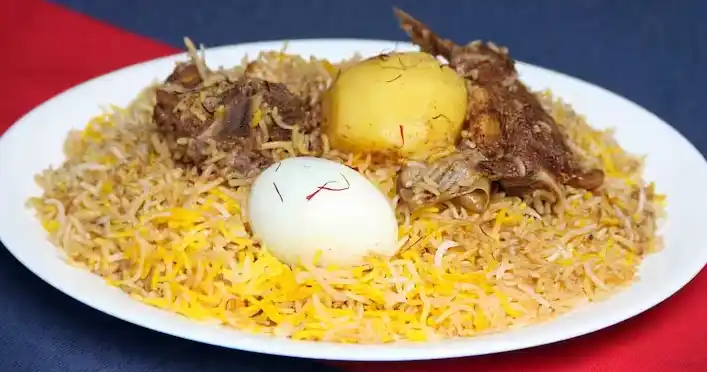
3. Lucknowi (Awadhi) Biryani
This is also known as Awadhi biryani, is the refined version from the royal kitchens of Lucknow. This style of biryani is all about balance and elegance, using a lighter hand with spices. The rice and meat are cooked separately, and then layered to form a perfect marriage of flavors.
In Awadhi biryani, the focus is on the meat’s tenderness and the subtle use of ingredients like kewra (pandanus flower water), saffron, and rose water to elevate the dish. The dum technique is essential here, allowing the rice to absorb the essence of the meat and spices.
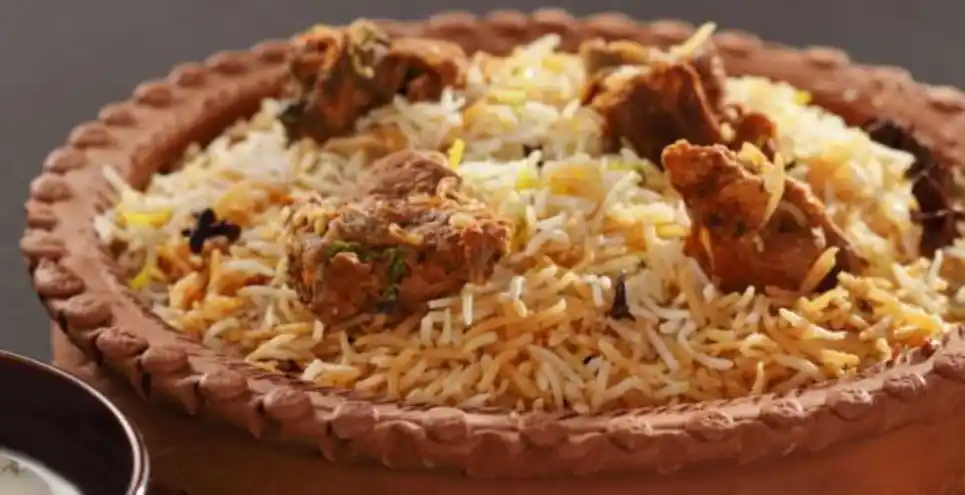
4. Malabar Biryani
A coastal gem, Malabar biryani hails from the southern Indian state of Kerala, where it has gained immense popularity. It is primarily made with short-grain rice called kaima or jeerakasala, which sets it apart from the long-grain basmati used in other parts of the country.
What makes Malabar biryani unique is its simplicity. The dish is less spicy than its northern counterparts, relying on fresh coconut milk, fried onions, and a few key spices like fennel seeds, cinnamon, and cloves. this item is traditionally served with a side of raita and pickles, balancing the flavors beautifully.

5. Ambur Biryani
This is , a lesser-known but equally delicious version, originates from Tamil Nadu. This is a famous for its fiery and tangy flavor, owing to the use of chili paste and curd. Typically made with seeraga samba rice, a smaller and more fragrant variety than basmati, Ambur biryani is a treat for those who enjoy robust and spicy flavors.
Ambur biryani is a straightforward, no-frills biryani, often served with a boiled egg and a side of brinjal curry or dalcha (a lentil-based curry). The simplicity of the dish allows the meat and spices to shine without overpowering the palate.

6. Thalassery Biryani
Another biryani from Kerala, Thalassery biryani is a celebration of local flavors and cooking techniques. Like Malabar biryani, it uses short-grain rice, but what sets it apart is the use of ghee, dried fruits, and a milder spice mix. The rice is cooked separately from the meat and then layered together in the final stages.
It has a sweeter flavor profile due to the use of caramelized onions and raisins, making it distinct from the spicier northern versions. The coastal influence is evident, with seafood sometimes being used instead of traditional meat.
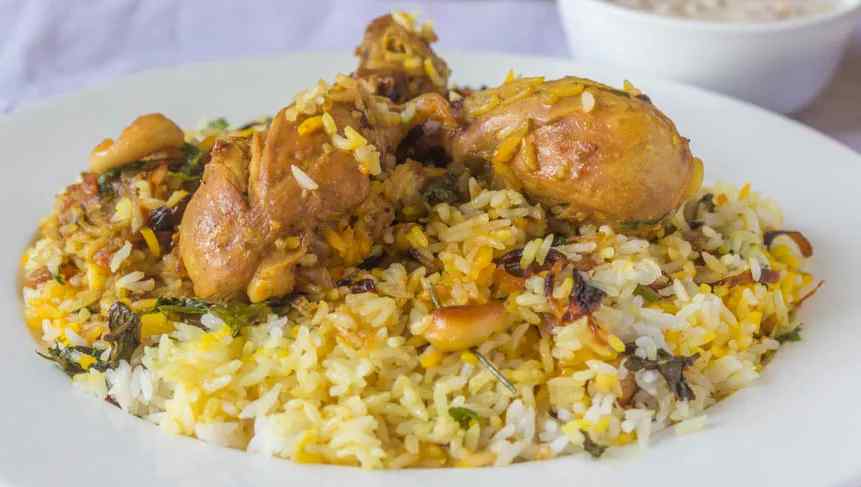
7. Dindigul Biryani
This is yet another Tamil Nadu variation, named after the town of Dindigul. This version is known for its zesty flavor, with a heavy use of black pepper and yogurt. Seeraga samba rice is used here as well, giving it a distinct texture.
The meat, usually chicken or mutton, is marinated with curd, lime juice, and a mixture of spices before being cooked with the rice. The resulting biryani has a tangy, slightly sour taste, making it a unique offering in the biryani world.
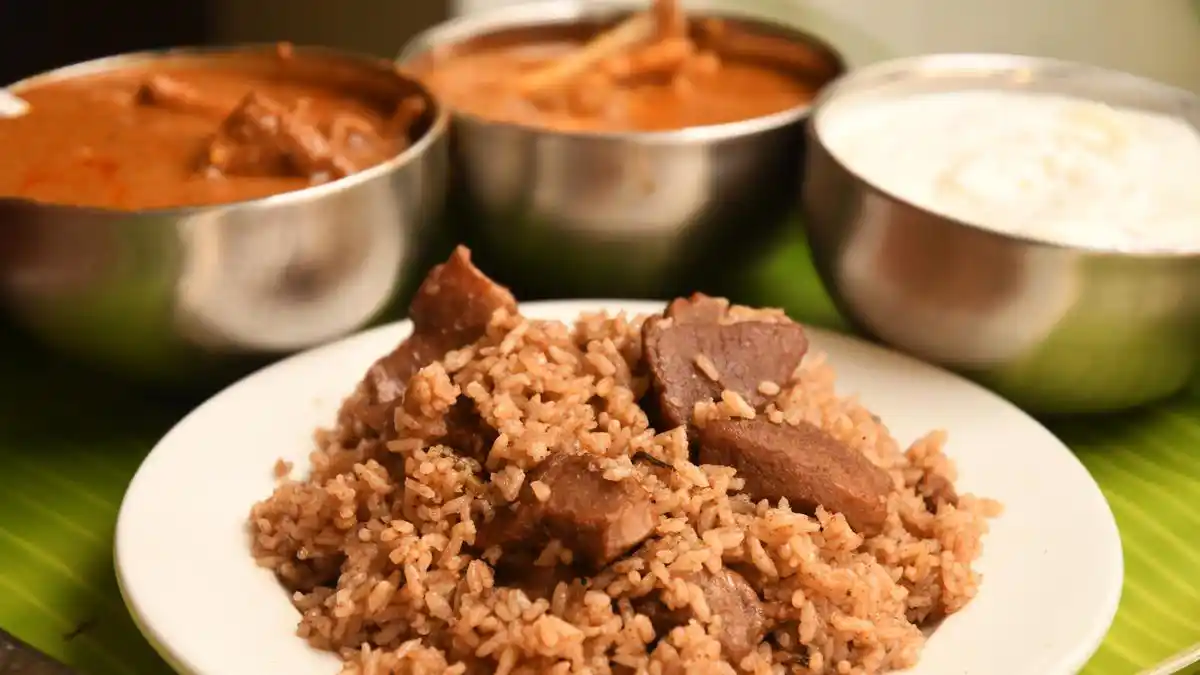
8. Sindhi Biryani
Sindhi biryani, popular in Pakistan and parts of North India, is a more rustic, hearty version of the dish. It is known for its bold flavors, vibrant colors, and generous use of spices like red chili powder, cumin, coriander, and garam masala. Yogurt, tomatoes, and potatoes are added to enhance the richness of the dish.
Sindhi biryani is often served with a side of spicy salan (gravy) and cooling raita, making it a meal that is both fiery and refreshing.
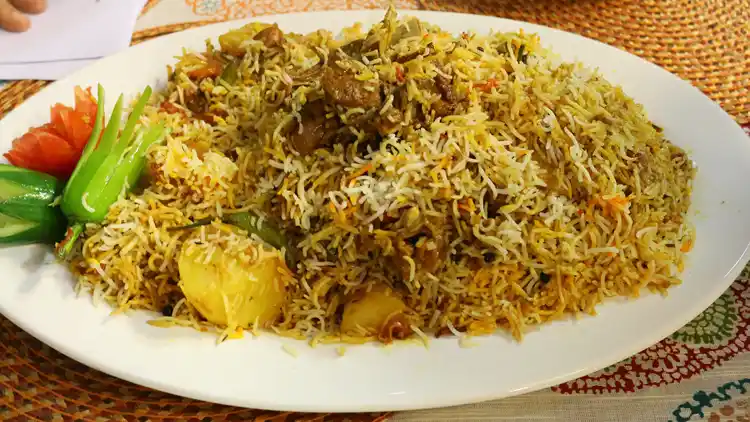
9. Bombay Biryani
The bustling city of Mumbai has its own version of biryani, known for its sweetness, spiciness, and richness. Bombay biryani often includes fried potatoes and plums, adding a distinct sweetness to the dish. The use of kewra water or rose water adds a floral aroma to the biryani, enhancing its overall flavor.
Bombay biryani is a favorite in the city’s street food scene and is often enjoyed with a side of cooling raita or papad.

The Ingredients a Symphony of Flavors
The beauty of biryani lies in the harmony of its ingredients. Whether it’s a simple home-cooked version or a royal Mughlai affair, biryani is a delicate balance of rice, meat (or vegetables), and spices. Here’s a closer look at the key components:
1. Rice
The most important component of the most loved dish is, of course, the rice. Basmati rice is the most commonly used variety, known for its long grains and fragrant aroma. However, in some regional variations like Thalassery and Dindigul biryani, short-grain varieties such as kaima or seeraga samba are preferred.
The rice is usually cooked partially (about 70% done) before being layered with the meat or vegetables, ensuring that it finishes cooking during the dum process, absorbing all the flavors.
2. Meat or Vegetables
Traditionally, this is made with either chicken, lamb, mutton, or beef, depending on the region and cultural preferences. The meat is marinated with a mixture of yogurt, lemon juice, and spices to enhance its tenderness and flavor. In coastal areas, seafood like prawns or fish is sometimes used.
Vegetarian versions of biryani are also popular, especially in regions like Hyderabad, where veg biryani is a common offering. Paneer, potatoes, carrots, beans, and peas are often used as substitutes for meat, providing a hearty and flavorful vegetarian alternative.
3. Spices
The Dish is known for its aromatic and flavorful spices. The exact blend of spices can vary depending on the regional variation, but the key players include:
- Cumin: Adds an earthy, warming flavor to the dish.
- Coriander: Provides a citrusy brightness.
- Cinnamon: Adds a sweet, woody note.
- Cardamom: Imparts a floral, citrusy aroma.
- Cloves: Adds a sharp, pungent flavor.
- Bay Leaves: Enhances the overall fragrance.
- Nutmeg and Mace: Used in Mughlai versions to add warmth and sweetness.
- Red Chili Powder: Adds heat, especially in spicier versions like Ambur or Sindhi biryani.
- Saffron: Adds a golden hue and a subtle floral aroma, especially in Hyderabadi or Mughlai biryani.
These spices are often combined into a garam masala mix, which forms the backbone of the biryani’s flavor profile.
4. Ghee and Oil
A good dish requires a generous amount of fat, traditionally ghee (clarified butter), which adds richness and depth to the dish. In some versions, like Malabar biryani, coconut oil is used, adding a distinct flavor. The fat helps to carry the spices and enhances the overall texture of the dish.
5. Aromatics: Onions, Garlic, and Ginger
Caramelized onions are a key ingredient in most biryanis, providing sweetness and depth. Garlic and ginger, either minced or made into a paste, are also essential, adding pungency and warmth to the dish.
The Art of Cooking Biryani a Labor of Love
Making This Dish is an art form, requiring patience, precision, and an understanding of how flavors meld together. The process can be broken down into a few key stages:
1. Marinating the Meat
The first step in making biryani is marinating the meat, which helps to tenderize it and infuse it with flavor. The marinade typically consists of yogurt, lemon juice, ginger-garlic paste, and a mixture of spices like cumin, coriander, chili powder, and garam masala. The meat is left to marinate for a few hours, or even overnight, allowing the flavors to penetrate deeply.
2. Preparing the Rice
The rice is parboiled in salted water with whole spices like bay leaves, cloves, and cinnamon sticks. It is cooked until it is about 70% done, leaving it firm enough to absorb the juices and flavors during the final cooking stage.
3. Layering
The hallmark of a great Dish is the layering technique. In a large, heavy-bottomed pot, layers of marinated meat (or vegetables) are alternated with partially cooked rice. Each layer is often sprinkled with saffron-infused milk, caramelized onions, and a drizzle of ghee. This layering process is crucial, as it ensures that every bite of biryani has a perfect balance of rice, meat, and spices.
4. Dum Cooking
Once the layers are assembled, the pot is sealed tightly with a lid and sometimes even dough, trapping the steam inside. This method of cooking, known as dum, allows the flavors to meld together slowly, resulting in a dish that is rich, aromatic, and deeply flavorful. The heat is kept low to prevent burning, and the this dish is cooked for about 30-40 minutes until the rice is fully cooked and the meat is tender.
Biryani a Cultural and Social Phenomenon
It is more than just a meal in India; it is a cultural symbol of hospitality, celebration, and community. From grand feasts to humble home kitchens, biryani is a dish that brings people together.
1. Biryani at Festivities
This food Item is a staple at weddings, festivals, and special occasions in India. Whether it’s Eid, Diwali, or a family gathering, biryani is often the centerpiece of the meal. The labor-intensive process of making biryani is a labor of love, and it is often prepared in large quantities to be shared among friends and family.
2. Street Food Culture
In cities like Hyderabad, Mumbai, and Delhi, The Dish is an integral part of the street food culture. Vendors selling steaming pots of biryani are a common sight, especially during lunchtime when office-goers and students flock to grab a plate of this delicious dish.
3. Biryani in Popular Culture
It has also found a place in popular culture, often being referenced in films, music, and literature. In Bollywood, the love for biryani is frequently depicted in scenes involving family gatherings, celebrations, or romantic dinners. The dish has become a symbol of indulgence, comfort, and happiness.
The Global Spread of Biryani
Over time, Biryani has transcended borders and become a global dish, beloved by food enthusiasts worldwide. Indian diasporas in countries like the UK, the USA, and the Middle East have popularized in their adopted homes, where it is now commonly available in restaurants and takeout joints.
The popularity of biryani has also led to the rise of fusion versions, incorporating local ingredients and culinary techniques. For example, biryani in the UK might include elements of British cuisine, such as vegetables like carrots and peas, while Middle Eastern versions might include dried fruits and nuts.
how to make biryani at home
Making biryani at home may seem intimidating due to the number of ingredients and the complexity of the cooking process. However, with a little patience and the right techniques, you can recreate the magic of dish in your kitchen. Here is a step-by-step guide to making authentic biryani:
Ingredients
For the marinade:
- 500g chicken or lamb, cut into pieces
- 1 cup yogurt
- 2 tbsp ginger-garlic paste
- 1 tsp turmeric powder
- 1 tsp red chili powder
- 1 tsp garam masala
- Salt to taste
- Juice of 1 lemon
For the rice:
- 2 cups basmati rice, soaked for 30 minutes
- 4 cups water
- 2 bay leaves
- 4 cloves
- 2 cardamom pods
- 1 cinnamon stick
- Salt to taste
For the biryani:
- 2 onions, thinly sliced
- 2 tbsp ghee
- 2 tbsp vegetable oil
- 1 tsp cumin seeds
- 4 green chilies, slit
- 1 tsp coriander powder
- 1 tsp cumin powder
- 1/2 tsp garam masala
- 1/4 cup chopped mint leaves
- 1/4 cup chopped cilantro (coriander)
- A few strands of saffron soaked in 2 tbsp warm milk
- Fried onions for garnish
Instructions
Step 1: Marinate the Meat
In a large bowl, combine the yogurt, ginger-garlic paste, turmeric, chili powder, garam masala, salt, and lemon juice. Add the chicken or lamb pieces and coat them thoroughly with the marinade. Cover and refrigerate for at least 2 hours (or overnight for best results).
Step 2: Prepare the Rice
Bring water to a boil in a large pot. Add the soaked rice, bay leaves, cloves, cardamom pods, cinnamon stick, and salt. Cook the rice until it is about 70% done (the grains should still be firm). Drain and set aside.
Step 3: Cook the Onions
Heat ghee and oil in a large pan over medium heat. Add the sliced onions and cook until golden brown and caramelized. Remove half of the onions and set them aside for garnishing.
Step 4: Cook the Meat
To the remaining onions in the pan, add cumin seeds, green chilies, coriander powder, cumin powder, and garam masala. Cook for 1-2 minutes until fragrant. Add the marinated meat and cook until the meat is browned on all sides. If using lamb, you may need to cook it for longer until tender.
Step 5: Layer
In a large, heavy-bottomed pot, start by adding a layer of the cooked meat at the bottom. Follow with a layer of rice. Sprinkle some chopped mint, cilantro, and saffron-infused milk on top. Repeat the layers until all the meat and rice are used up. Finish with a layer of rice and top with fried onions.
Step 6: Dum Cooking
Cover the pot tightly with a lid or aluminum foil to trap the steam. Place the pot on low heat and cook for 20-30 minutes, allowing the flavors to meld together. Alternatively, you can place the pot in a preheated oven at 180°C (350°F) for the same duration.
Step 7: Serve
Once the biryani is cooked, gently fluff the rice with a fork, making sure not to break the grains. Serve hot with raita, salad, or pickles.
Conclusion
This is a dish that defies definition. It is a celebration of India’s diverse culinary traditions, blending the influences of different cultures, regions, and eras into a single, harmonious creation. Whether you prefer the robust flavors of Hyderabadi biryani, the subtle elegance of Lucknowi biryani, or the tangy spiciness of Ambur biryani, one thing is certain: biryani is more than just a meal. It is a story told through food, a journey that takes you through the history, culture, and soul of India.
In every bite of this dish, you can taste the layers of history and culture that have shaped this dish over centuries. It is a dish that will continue to evolve, adapt, and inspire new generations of cooks and food lovers, keeping the love affair with biryani alive for years to come.

Superb post, I learned so much! Glad I came across this.
Thank You For Your Response Outbrain